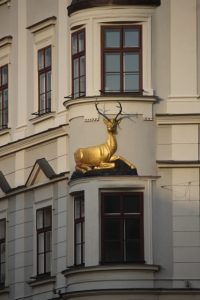With pleasant but abandoned student town Olomouc as base, we go to Brno, the second largest city in Czech Republic, and a nice alternative to the many medieval towns we have seen so far.
We have moved to Olomouc, an attractive student town and our next base in Moravia. Of course, in July there are no students, and it is very quiet in town: a local concert in the central square attracts perhaps 50 people, most terraces are less than half full, and that is not because of Corona fear.
As so many other Czech towns Olomouc has a lovely old cobbled square, with pastel-coloured houses, an impressive radnice – town hall – being refurbished, several fountains and all the other hallmarks. But to be honest, we are getting towards ‘historic square saturation’: there are simply too many cobbled squares, pastel-coloured houses, radnices and fountains in this country. Not to mention gothic and Renaissance churches, castles and palaces. At least, Olomouc has created some diversification by allowing modern art to appear in its streets, too. In the university quarter a copper figure climbs along the roof edge of a building, not far away from a mural showing a king taking a selfie.
But Olomouc was going to be a base only, and as such it serves perfectly well.
It is an hour, or so, to Brno, Czech’s second-largest city. We decided to leave the car at the hotel in Olomouc, and travel to Brno by public transport – preferably by train. But the next train was not going to leave in until well over an hour, so we opted for the bus instead. Quick, direct, and we would arrive even before the train had left the station. Well, except for the traffic: the bus trip in the end took the best of two hours. (With our own car we would have had the same traffic issues, of course.)
Brno, too, has something called the Old City, the for Czech cities usual inner core, with the obligatory castle – which we left for some other time -, its multiple churches in multiple building styles, in this case Gothic to Baroque, and its cobbled streets that have mostly been turned into pedestrian area – although the tram is allowed in. But the architectural styles are more varied, there is less of a medieval, UNESCO-protected, atmosphere around. In fact, there is a certain buzz in town. The main square has an outside market. Terraces are full, with lots of young people.
We first climb the tower of the ‘stara radnice’, the old town hall, which provides a great 360o view over the city. But for the details, one has to wander the streets. Some of the passages stink, some of the houses in the back streets have been boarded up, things we have not yet experienced in the Czech Republic. But there is plenty to admire, too. The decorated facades, the heavily burdened sculptures at door entrances or below balconies. The ‘house of the four idiots’ (Dum u Ctyr Mamlasu, in Czech) – I love those names! – , or the ‘house of the lords of Lipa’ (Dum z Pane Lipe), full of Renaissance-type sgraffito apparently added as late as 1938, both on the main square. And another of my favourites, the Centrum building, the vision of shoe magnate Thomas Bata, founder of the epic Czech company Bata Shoes. When it was built in 1928, the intention was to build it to 28 stories high, thereby making it the tallest building in Europe at the time. Except that planning permission never came through.
The most extravagant churches are the Baroque Minoritsky Church and the Loretanska Chapel, two churches next to each other in a cramped side-street, and linked by a door. But the most remarkable site is the crypt under a Capuchin church, where until the end of the 18th Century the monks that had passed away were laid to rest, in an environment that facilitated natural mummification. And where the moneyed elite of the town paid large sums to be buried, too, anticipating a short-cut to heaven. I think it has been redone for tourist, a bit, but here you find lots of dead bodies, mostly skeletons, both inside and outside coffins.
More recent additions to town are a strikingly modern building opposite the railway station, and a series of sculptures, placed at squares and intersection. Something we have seen in more Czech cities, especially in Prague. Makes a nice change from the sometimes overwhelming historical content of this country.
Having had more time to plan, we managed to get the 17.18 train back to Olomouc, just. There was a little confusion about platform numbers, but with a last minute spurt we just about caught our train – avoiding a two hour wait for the next one. Or avoiding clogged motorways at rush hour. Hmmm. It took us almost 2.5 hours, instead of the scheduled 1.5. somewhere things went wrong, we spent 30 minutes waiting at an intermediate station, then skipped a few what looked like pretty important places, presumably to make up time. But luckily the train did stop in Olomouc, where we got off. Next time the car, again?











































